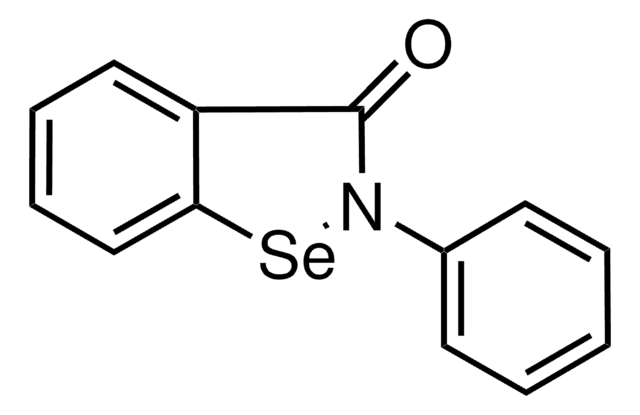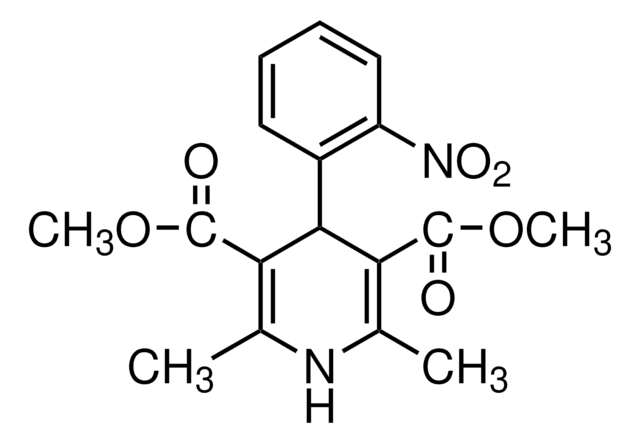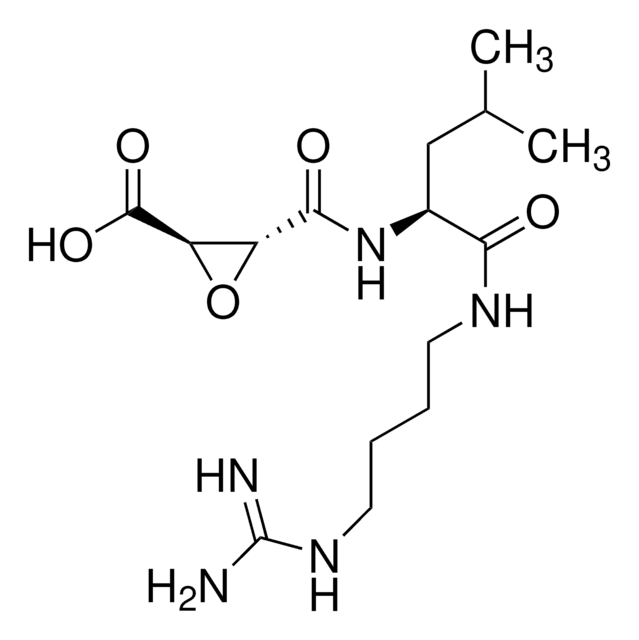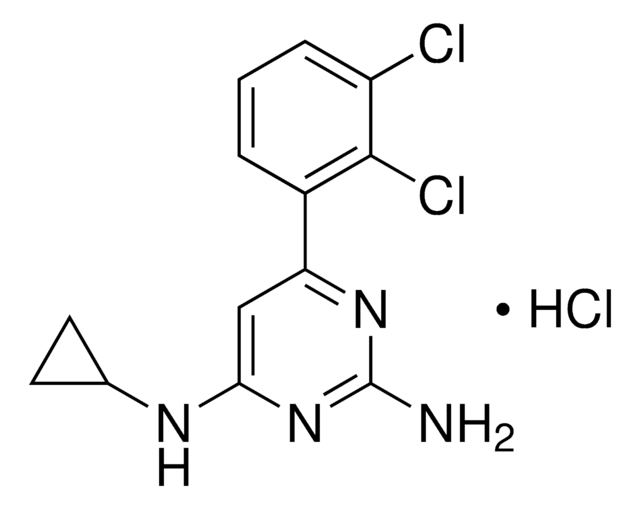C1480
Z-Phe-Ala fluoromethyl ketone
≥90% (TLC), powder
Sinônimo(s):
Z-FA-FMK
Faça loginpara ver os preços organizacionais e de contrato
About This Item
Fórmula linear:
C21H23N2O4F
Peso molecular:
386.42
Número MDL:
Código UNSPSC:
12352209
ID de substância PubChem:
NACRES:
NA.77
Produtos recomendados
Nível de qualidade
Ensaio
≥90% (TLC)
Formulário
powder
cor
white to off-white
solubilidade
DMSO or DMF: 20 mM
Condições de expedição
dry ice
temperatura de armazenamento
−20°C
cadeia de caracteres SMILES
C[C@H](NC(=O)[C@H](Cc1ccccc1)NC(=O)OCc2ccccc2)C(=O)CF
InChI
1S/C21H23FN2O4/c1-15(19(25)13-22)23-20(26)18(12-16-8-4-2-5-9-16)24-21(27)28-14-17-10-6-3-7-11-17/h2-11,15,18H,12-14H2,1H3,(H,23,26)(H,24,27)/t15-,18-/m0/s1
chave InChI
ASXVEBPEZMSPHB-YJBOKZPZSA-N
Aplicação
Z-Phe-Ala fluoromethyl ketone (Z-FA-FMK) has been used as a:
- cathepsin inhibitor to study its effects on dendritic cells
- papain-like cysteine protease inhibitor to study its effects on cadmium-induced mitochondrial apoptosis
- cysteine protease inhibitor to study its effects on the interaction of toll-like receptor 9 (TLR9) with granulin in RAW macrophages
Ações bioquímicas/fisiológicas
Z-Phe-Ala fluoromethyl ketone (Z-FA-FMK) is an inhibitor of cysteine proteases, such as cathepsin B and L. It can also inhibit recombinant effector caspases 2, -3, -6, and -7 and not initiator caspases 8 and -10. Z-FA-FMK plays a role in blocking nuclear factor κ-light-chain-enhancer of activated B cells (NF-κB) transactivation. It exhibits therapeutic effects against rheumatoid arthritis.
Código de classe de armazenamento
11 - Combustible Solids
Classe de risco de água (WGK)
WGK 3
Ponto de fulgor (°F)
Not applicable
Ponto de fulgor (°C)
Not applicable
Equipamento de proteção individual
Eyeshields, Gloves, type N95 (US)
Escolha uma das versões mais recentes:
Já possui este produto?
Encontre a documentação dos produtos que você adquiriu recentemente na biblioteca de documentos.
Transcription factor E3 protects against cadmium-induced apoptosis by maintaining the lysosomal-mitochondrial axis but not autophagic flux in Neuro-2a cells
Pi H, et al.
Toxicology Letters, 295(4), 335-350 (2018)
Yun-Pei Zhang et al.
American journal of physiology. Gastrointestinal and liver physiology, 311(6), G1091-G1104 (2016-10-30)
LPS-induced microvascular hyperpermeability and hemorrhage play a key role in the development of sepsis, the attenuation of which might be an important strategy to prevent sepsis. However, the current clinical therapies have proven to be inefficient in improving the prognosis
Man Kyu Shim et al.
Journal of controlled release : official journal of the Controlled Release Society, 294, 376-389 (2018-12-15)
Cancer nanomedicine using nanoparticle-based delivery systems has shown outstanding promise in recent decades for improving anticancer treatment. However, limited targeting efficiency, low drug loading efficiency and innate toxicity of nanoparticles have caused severe problems, leaving only a few available in
Michael J Mitchell et al.
Nature communications, 8, 14179-14179 (2017-03-21)
Physical forces affect tumour growth, progression and metastasis. Here, we develop polymeric mechanical amplifiers that exploit in vitro and in vivo physical forces to increase immune cytokine-mediated tumour cell apoptosis. Mechanical amplifiers, consisting of biodegradable polymeric particles tethered to the
Katherine A Staines et al.
Journal of cellular physiology, 231(6), 1392-1404 (2015-12-08)
The transmembrane glycoprotein E11 is considered critical in early osteoblast-osteocyte transitions (osteocytogenesis), however its function and regulatory mechanisms are still unknown. Using the late osteoblast MLO-A5 cell line we reveal increased E11 protein/mRNA expression (P < 0.001) concomitant with extensive osteocyte dendrite
Nossa equipe de cientistas tem experiência em todas as áreas de pesquisa, incluindo Life Sciences, ciência de materiais, síntese química, cromatografia, química analítica e muitas outras.
Entre em contato com a assistência técnica








